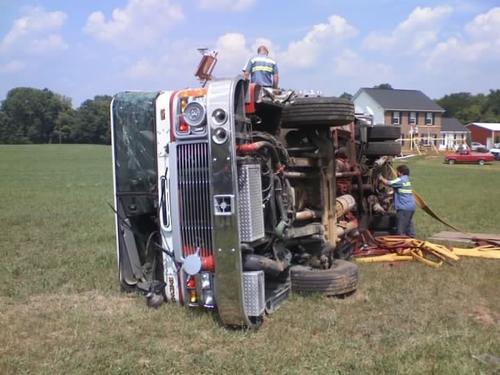First respondersSmart traffic system to reduce first responder deaths
Nearly 13 percent of the firefighters and police officers who die in the line of duty are killed in vehicle-related incidents, and fire trucks are involved in 10 times as many collisions as other heavy truck; University of Arizona researchers have teamed up with the Maricopa County Department of Transportation (MCDOT) to create a system that will make intersections safer for emergency responders and the general public

This fire truck rolled over while avoiding a collision // Source: hamiltoncountyfirefighters.com
Thugs and fires are obvious threats for police and firefighters, but traffic accidents also pose a serious danger for these first responders.
Nearly 13 percent of the firefighters and police officers who die in the line of duty are killed in vehicle-related incidents, and fire trucks are involved in 10 times as many collisions as other heavy trucks.
University of Arizona researchers have teamed up with the Maricopa County Department of Transportation, or MCDOT, in an effort radically to lower these statistics by creating a system that will make intersections safer for emergency responders and the general public.
They are installing a prototype at six intersections in Maricopa County at Anthem, Ariz., north of Phoenix, and will test it this summer, according to Larry Head, of the UA College of Engineering’s systems and industrial engineering department, and Faisal Saleem, MCDOT Intelligent Transportation Systems branch manager.
Their efforts are part of a national push to create smart vehicles that communicate with one another and with traffic control systems. In 2013 the National Highway Traffic Safety Administration, which mandates seatbelts for all cars and trucks, may require every vehicle sold in the United States to be equipped with this technology, which could nearly eliminate rear-end collisions, red-light running and left-turn smashups.
The system being installed in Maricopa County could be one of the first steps in deploying a smart-vehicle system throughout the country, Head said.
“There’s the question of which comes first, the intelligent cars or the infrastructure to support them,” he said. “If we install a system for emergency vehicles, it could be the core infrastructure and the pathway to deployment. As the nation’s public and private vehicle fleets are renewed, this system could lead the way in making intersections safer.”
The MCDOT intersections at Anthem will be equipped with dedicated short-range communications radios. Daisy Mountain Fire District trucks, Maricopa County REACT vehicles and some transit vehicles also will carry the short-range radios. All the vehicles will be tracked by GPS.
REACT stands for Regional Emergency Action Coordinating Team. It provides traffic management on arterial roads in Maricopa County, and coordinates the efforts of multi-agency and multi-jurisdictional fire trucks, ambulances, police cars and EMT vehicles.
When one or more emergency vehicles approach an intersection, one will be given a green light, while other vehicles in the area will be held up until the intersection is clear. Each vehicle also will be in contact with
